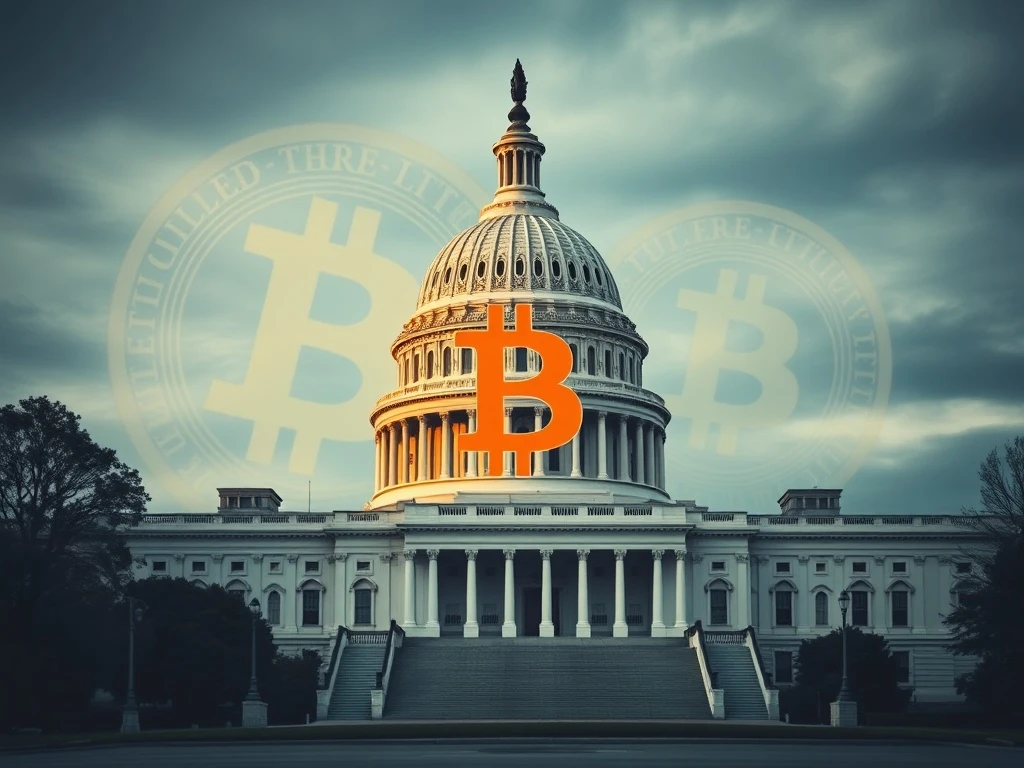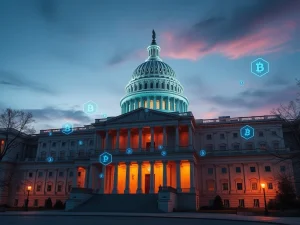Bitcoin Reserve: US Congress Advances Crucial Report on Digital Asset Strategy

The prospect of a national Bitcoin reserve is gaining significant traction within the United States. Recent legislative moves highlight a serious commitment to exploring how the U.S. government could establish and manage a strategic stockpile of digital assets. This development marks a pivotal moment for US Congress Bitcoin discussions, moving from conceptual ideas to concrete legislative action.
US Congress Initiates Strategic Digital Asset Study
Lawmakers in the United States have introduced a significant bill. This legislation directs the US Treasury to conduct a comprehensive study. The study will examine the feasibility and technical considerations for establishing a strategic Bitcoin reserve and a broader strategic digital asset stockpile. Representative David P. Joyce introduced this House appropriations bill on Friday. It contains specific sections outlining the requirements for the Treasury Department.
Within 90 days of the bill’s enactment, the Treasury Department must present a detailed report. This report will cover several critical aspects of digital assets held by the federal government. These include:
- Feasibility: Assessing the practicality of creating and maintaining such a reserve.
- Custody: Determining secure methods for storing digital assets.
- Legal Authority: Identifying the necessary legal frameworks for government ownership.
- Cybersecurity Measures: Ensuring the robust protection of these assets from threats.
Furthermore, the bill mandates that the agency outline its plan for interagency transfers. It also requires a clear methodology for representing these assets on the federal government’s balance sheet. The report will identify all third-party contractors potentially responsible for asset custody. Importantly, the Treasury Department must also detail any hurdles to implementation. It needs to gauge the impact the reserve will have on the Department of the Treasury Forfeiture Fund.
The Genesis of a Government Bitcoin Reserve
The concept of a strategic Bitcoin reserve is not entirely new. In March, US President Donald Trump signed an executive order. This order aimed to establish both a strategic Bitcoin reserve and a digital asset stockpile. The plan involves using crypto assets confiscated by the government to fund these initiatives. This proactive step underscored a growing recognition of digital assets’ strategic importance. Treasury Secretary Scott Bessent has also confirmed the agency’s exploration of “budget-neutral pathways.” These pathways aim to bolster the potential Bitcoin reserve without direct appropriations. This new bill therefore represents a tangible progression in the US’s broader plan to create such a reserve. It signifies a legislative push to formalize and operationalize the executive order’s intent.
Examining the Implications for US Crypto Policy
The proposed report holds significant implications for future crypto regulation US policy. By demanding a detailed analysis of feasibility, custody, and legal authority, Congress is laying the groundwork for a more structured approach to digital assets. This move suggests a shift towards viewing cryptocurrencies not just as a financial instrument but as a strategic national asset. The report will provide essential data and recommendations. These will inform future legislative decisions regarding digital asset management and oversight. This initiative could set a precedent for how governments globally integrate digital currencies into their national financial strategies. It also signals a maturing perspective on the role of cryptocurrencies in national security and economic stability.
Representative Joyce emphasized the broader goals of his legislation. In a post to X, he expressed gratitude to the House Appropriations Committee for advancing the bill. He stated, “This legislation ensures the federal government is fiscally responsible, leverages new technology, and is focused on national security.” His comments highlight the multifaceted objectives behind establishing a government-backed digital asset strategy. It combines economic prudence with technological innovation and national security imperatives.
Global Momentum: Other Nations Pursue Digital Asset Reserves
The United States is not alone in its pursuit of a strategic Bitcoin reserve. Other countries are also ramping up efforts in this area. This global trend underscores the increasing recognition of digital assets as important national resources. For instance, Kassym-Jomart Tokayev, the president of the Republic of Kazakhstan, recently outlined his country’s crypto endeavors. He specifically floated the idea of creating a state fund for digital assets. The purpose is to accumulate “promising assets in the new digital financial system.” This initiative demonstrates Kazakhstan’s forward-thinking approach to leveraging the digital economy.
Similarly, the Philippines’ Congress was considering a proposal in August. This proposal aimed to establish a strategic reserve of 10,000 Bitcoin. If enacted, the Philippines could become the first country in Southeast Asia to adopt Bitcoin as a strategic asset. Such a move would significantly impact regional financial dynamics. It would also potentially inspire other nations to follow suit. These international developments highlight a growing consensus among nations regarding the strategic value of cryptocurrencies. According to Bitbo, countries currently holding Bitcoin in their respective reserves exceed 517,000 BTC. This amount represents approximately 2.46% of Bitcoin’s total supply. This figure is expected to grow as more nations explore digital asset integration.
Deep Dive into Treasury Department Report Requirements
The mandated Treasury Department report is extensive. It requires detailed planning and foresight. The report must address not only the “how” but also the “why” and “what if” scenarios. For example, considering interagency transfers means establishing clear protocols for moving digital assets between government bodies. This process would require robust security measures and transparent accounting. Representing assets on the federal balance sheet also presents unique accounting challenges. Digital assets often experience high volatility. This characteristic necessitates new valuation and reporting standards. The involvement of third-party contractors for custody raises questions about security, vendor vetting, and potential single points of failure. The report will need to address these complexities comprehensively.
Furthermore, identifying potential hurdles to implementation is crucial. These could range from technological limitations to legal ambiguities or even political resistance. The impact on the Department of the Treasury Forfeiture Fund is another key area. This fund currently holds assets seized from criminal activities. Integrating confiscated crypto into a strategic reserve would require careful consideration of legal precedents and operational procedures. Ultimately, this report will serve as a foundational document. It will guide the US government’s approach to digital assets for years to come. Its findings will inform future legislative efforts and policy decisions.
Navigating Challenges and Opportunities in Crypto Regulation US
Establishing a strategic Bitcoin reserve presents both significant opportunities and considerable challenges. On the opportunity side, it could:
- Enhance National Security: Provide a secure, censorship-resistant asset for geopolitical stability.
- Promote Fiscal Responsibility: Potentially leverage confiscated assets to strengthen national reserves.
- Foster Innovation: Encourage further development in blockchain technology and cybersecurity within the US.
- Strengthen Global Standing: Position the US as a leader in digital asset adoption and management.
However, challenges also abound. These include:
- Market Volatility: Managing a reserve of highly volatile assets requires sophisticated strategies.
- Regulatory Frameworks: Developing clear and consistent crypto regulation US policies is essential.
- Technological Expertise: Ensuring the government possesses the necessary technical skills for secure custody and management.
- Public Perception: Building trust and understanding among the general public regarding government crypto holdings.
The successful navigation of these challenges will depend heavily on the insights provided by the Treasury Department’s upcoming report. This report will be instrumental in shaping a resilient and effective national digital asset strategy.
The Road Ahead for the Strategic Digital Asset Initiative
The journey for this bill is still ongoing. It will be considered by the full House of Representatives. If it passes there, it will then move to the Senate for further review and debate. The legislative process can be lengthy and complex. However, the introduction of this bill signals a clear intent from a segment of Congress to push forward with a national digital asset strategy. The ultimate outcome will have far-reaching implications. It will affect the future of US Congress Bitcoin policy. It will also influence the broader landscape of global digital asset management. Stakeholders across the cryptocurrency industry and traditional finance will watch these developments closely. The potential for the US to establish a robust strategic digital asset reserve could redefine its economic and geopolitical posture in the digital age.










